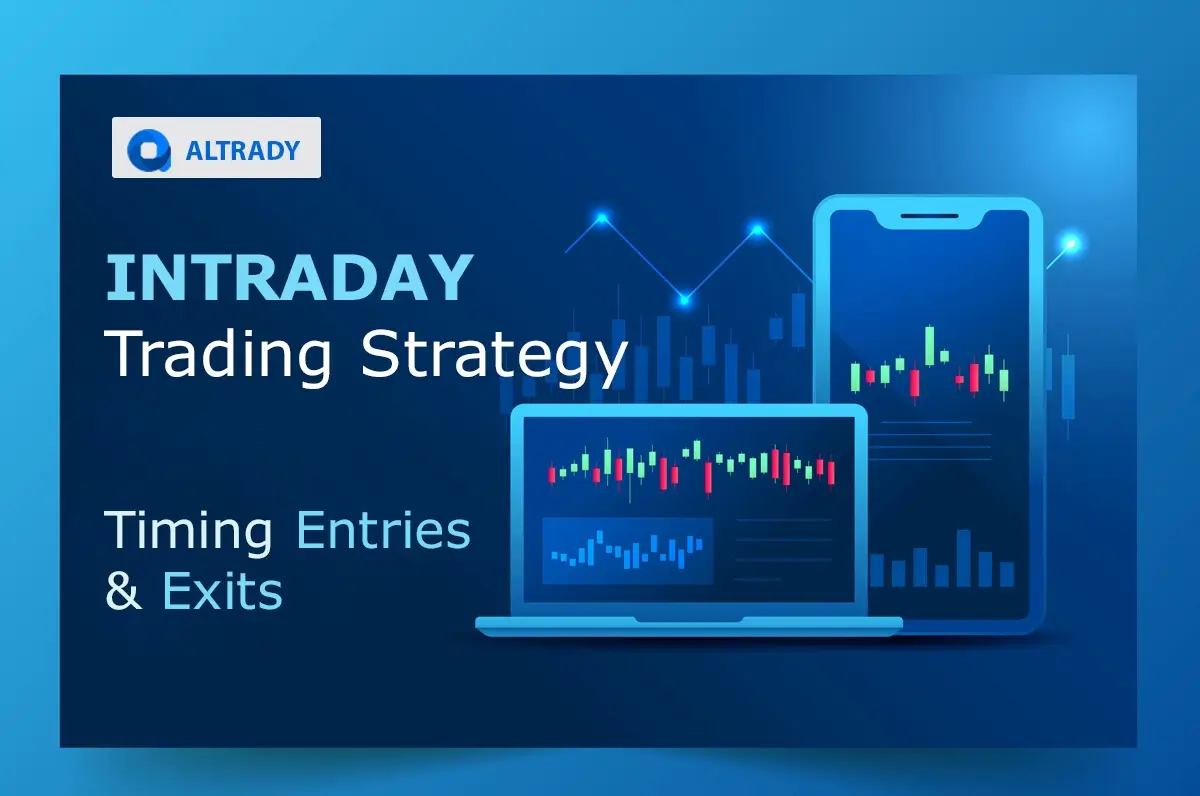Category List


Intraday Trading Strategy: Timing Entries and Exits
Intraday trading is a short-term procedure for cryptocurrency markets in which traders aim to capitalize on the daily price fluctuation of digital assets.
Several strategies can be suitable in this trading method, from addressing trends or ranges to news releases and opening or closing markets. Even scalping can be a secondary strategy for a day trading session.
In the following sections, we will dive into techniques for timing entries and exits employing multiple scenarios.
Understanding Intraday Trading
Intraday is the most extended method since it offers various opportunities for generating consistent profits across different asset classes over a week for an entire month. However, the success of this type of trading will depend significantly on the traders' performance. The risks associated with day trading are not minor things.
Stress and psychological factors are the primary aspects affecting traders' market survival capabilities. Such factors can lead to irrational behaviors like overtrading or revenge trading, which can be detrimental to the equity balance of their accounts.
Overcoming the intraday trading odds demands a deep understanding of the market dynamics and structure, price action, institutional participation, technical analysis techniques, circumstantial fundamental events affecting a crypto asset, and last but not least, the self-awareness of traders' weaknesses and strengths.
Relevant Concepts For Day Trading
One characteristic discussed among most day traders is keeping clean charts or naked charts. It means trading without relying on indicators, focusing instead on analyzing the market structure and seeking a deep comprehension of the forces shaping it.
From the previous declaration, we can conclude that price action goes hand in hand with technical analysis for the intraday market analysis, where price action reading aims to decipher the background influence on price movements, and technical analysis tries to confirm market events based on historical price chart data.
Likewise, the discussion of ICT vs. SMC takes a pertinent place for intraday traders, who can benefit a lot from ICT techniques like order block analysis at the time that SMC provides them with a reliable framework for order flow dynamics comprehension. Both ICT and SMC concepts also address the issue of institutional manipulation.
Although the naked chart is a popular concept in the day trading sphere, indicators are not necessarily tools to go without, and, in the case of the volume indicator, it plays a substantial role for day traders striving for specific price momentum. For instance, the volume analysis can provide insights into when big players, like institutions, are entering the market. Typically, this indicator increases during market sessions opening and closing or news releases, following a meaningful price movement, while a decrease signals small price fluctuations and lower participation.
The confluence of the concepts exposed previously establishes a reliable framework for discovering high-probability trade setups and timing entries and exits accurately.
Aspects of Intraday Trading
- Consistent profits: Mastering day trading offers the opportunity to gain money daily. However, it requires experience managing risks and potential losing streaks.
- Riskier Method: The daily exposition to markets places a hazard approach for traders. Potential profits are always susceptible to further losses.
- Amplify gains and losses: Capitalizing on small price fluctuations requires high amounts of money. For small balances, leverage is a solution at the cost of more risks.
- Stressful environment: Intraday trading demands monitoring markets along with trade orders continually. This fact can impact traders' stress levels significantly.
Timing Entries And Exits
When it comes to timing trade entries and exits, traders can address different seasons in the market, like trends and ranges, and sharp price movements, like range expansion and news trading.
Intraday Trends
By tracing a trend line, traders can spot dynamic support and resistance levels shaped by higher lows in uptrends or lower highs in downtrends, respectively.
Entry:
- A pullback may offer continuation opportunities if it keeps above or below a moving average or trend line, according to the type of trend.
- Traders can enter after a range or trend line breakout for a reversal trend.
Exit:
- Traders can exit positions after a trendline breakout or moving average crossover.
- Traders can exit positions if the price action suggests a false breakout when this reverses rapidly against the entry point.
Intraday Ranges
Intraday range-bound will present sideways opportunities as the price moves between support and resistance areas.
Entry:
- Traders can enter a long position following a bullish candlestick pattern formation on the low-end support area.
- Traders can enter a short position following a bearish candlestick pattern formation on the high-end resistance area.
- To trade the middle area of a range is not recommended.
Exit:
- Traders can exit positions once the price reaches the low-end or high-end areas according to the position.
Potential Scalping opportunity at the resistance of the range
Range Expansion: Session Opening Manipulation
Range expansion refers to the price breaking beyond previous highs or lows in a sharp price movement. Typically, it occurs at the market opening, for example, the New York session. Institutional traders might provoke a false breakout on previous highs or lows in a manipulation movement to trap the rest of the participants.
Detecting this tactic will offer an opportunity for a reversal trade entry. The volume indicator alongside candlestick patterns confluence can help to forecast whether institutions are looking for a reversal after a false breakout or, in fact, a continuation.
Entry:
- When the price breaks above the previous high of the day, it signals a potential uptrend or a manipulation for a downtrend.
- When the price breaks below the intraday low, it indicates a potential downtrend or manipulation for an upside move.
Exit:
- Traders can measure the range and set an exit point based on the size.
- Traders can spot the highs or lows of prior days to stick with a potential trend for the intraday session aiming at those zones.
Trading The Closing Hour
The End-of-day strategy deserves a mention in this case. Trading the closing hours implies spotting the directional move of the day. Generally, after that directional move, the price consolidates, preparing other range expansion moves for the market closing.
So traders can set entries for:
- Continuation of the day's trend.
- Reversal movements.
- News can also affect these hours.
News Trading
The most easy but risky approach for timing intraday entries and exits. Scalpers are the best at these types of entries. During news releases, traders can:
- Set entries at the beginning of the movement.
- Exit quickly as the price reaches a relevant zone.
Understanding the meaning of the news is mandatory to predict the potential direction of the price.
Conclusion
Intraday trading is an excellent option for those seeking consistent potential profits. We addressed several concepts associated with it, like price action, manipulation, and even how ICT and SMC concepts present advanced techniques for day traders.
Day trading also offers several opportunities for timing trades from different viewpoints. For both trends and ranges, as for manipulation activity like range expansion movements or news trading, we exposed some techniques to enter and exit from such scenarios.
Altrady builds the foundation for intraday entries along a wide range of features like smart trading and charting tools to practice day trading concepts. Enroll in a free trial account with paper trading.

Catalin is the co-founder of Altrady. With a background in Marketing, Business Development & Software Development. With more than 15 years of experience working in Startups or large corporations.